The Wireless Battery Monitoring System Market is estimated to be valued at USD 2.5 billion in 2025 and is projected to reach USD 20.4 billion by 2035, registering a compound annual growth rate (CAGR) of 23.3% over the forecast period.
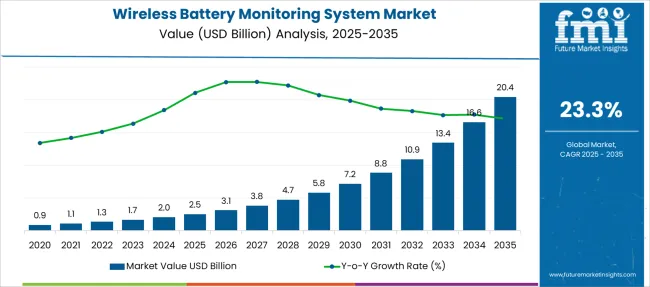
| Metric | Value |
|---|---|
| Wireless Battery Monitoring System Market Estimated Value in (2025 E) | USD 2.5 billion |
| Wireless Battery Monitoring System Market Forecast Value in (2035 F) | USD 20.4 billion |
| Forecast CAGR (2025 to 2035) | 23.3% |
The wireless battery monitoring system market is expanding rapidly as industries seek smarter and more efficient ways to manage battery health and performance. Increasing demand for reliable battery monitoring solutions is driven by the rise of electric vehicles, renewable energy storage, and portable electronics.
Technological advancements in wireless communication and sensor integration have improved real-time monitoring capabilities, enabling proactive maintenance and enhanced safety. Growing concerns over battery life, safety risks, and operational downtime are encouraging the adoption of wireless systems across sectors.
Regulatory standards focusing on battery management and safety have further accelerated market growth. Additionally, the automotive sector’s transition toward electric vehicles is creating significant opportunities for battery monitoring technologies. The market is expected to benefit from continued innovation in battery analytics and integration with IoT platforms. Segmental growth is anticipated to be led by hardware components, lithium-ion batteries as the primary battery type, and automotive applications due to the expanding electric vehicle market.
The market is segmented by Component, Battery Type, and Application and region. By Component, the market is divided into Hardware, Software, and Services. In terms of Battery Type, the market is classified into Lithium-ion, Lead Acid, and Others. Based on Application, the market is segmented into Automotive, Telecommunication, Aerospace & Defence, Energy and Utilities, BFSI, Health care, and Others. Regionally, the market is classified into North America, Latin America, Western Europe, Eastern Europe, Balkan & Baltic Countries, Russia & Belarus, Central Asia, East Asia, South Asia & Pacific, and the Middle East & Africa.
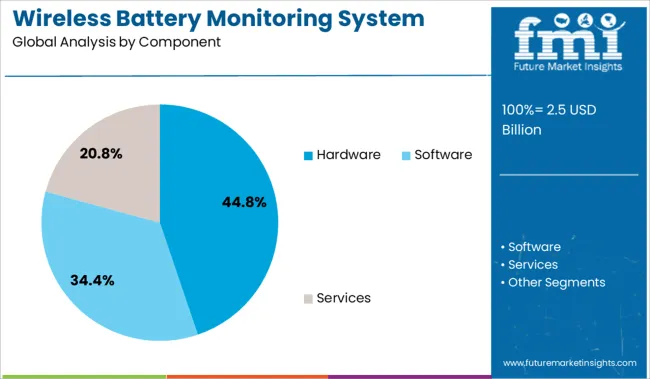
The hardware segment is projected to contribute 44.8% of the wireless battery monitoring system market revenue in 2025, holding the largest share among components. Growth of this segment is fueled by the critical role hardware plays in sensing, data collection, and wireless communication between batteries and monitoring platforms.
The demand for compact and energy-efficient hardware devices has risen as industries look for reliable, real-time data without compromising battery life. Hardware components such as sensors, transmitters, and control units have become increasingly sophisticated, supporting accurate measurements of voltage, temperature, and state of charge.
Manufacturers continue to develop hardware that is easy to integrate into existing battery systems, enabling seamless upgrades. As industries prioritize predictive maintenance and safety, the hardware segment is expected to sustain its leading position.
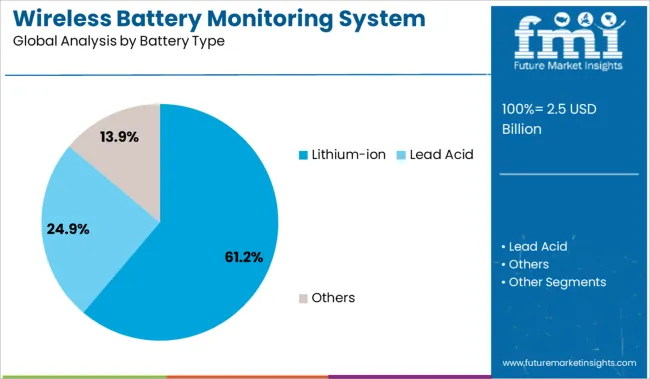
The lithium-ion battery type segment is projected to hold 61.2% of the market revenue in 2025, making it the dominant battery type for wireless monitoring systems. The widespread adoption of lithium-ion batteries in electric vehicles, consumer electronics, and energy storage has created a substantial need for monitoring solutions that address their specific performance and safety challenges.
Lithium-ion batteries require constant monitoring due to their sensitivity to temperature fluctuations and potential for thermal runaway. Wireless monitoring systems help in maintaining optimal battery health, extending battery life, and preventing safety hazards.
The segment benefits from the ongoing growth of the electric vehicle market and renewable energy sectors, where lithium-ion remains the preferred battery technology. With increasing focus on battery safety and performance, the lithium-ion segment is expected to continue its strong market presence.
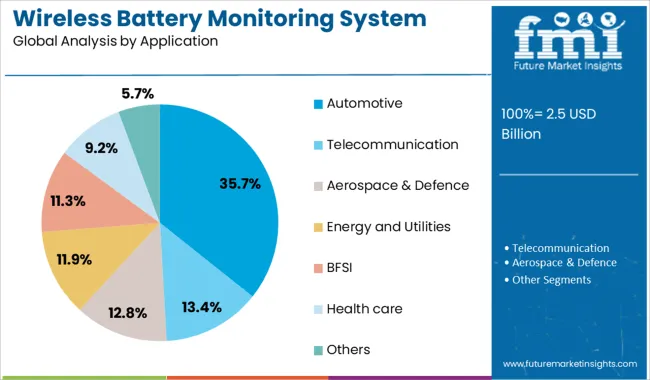
The automotive application segment is projected to account for 35.7% of the wireless battery monitoring system market revenue in 2025, sustaining its position as the leading application area. The automotive industry’s shift toward electrification has driven significant demand for battery monitoring solutions to ensure vehicle safety, reliability, and performance.
Wireless battery monitoring allows real-time tracking of battery status, helping to optimize energy consumption and manage thermal conditions in electric vehicles. Regulatory requirements for battery safety and performance have encouraged automakers to incorporate advanced monitoring systems as standard features.
The growth in electric vehicle production and sales globally has further propelled this segment’s expansion. As automakers seek to improve battery management and extend vehicle range, the automotive segment is expected to maintain its dominant market share.
The adoption of batteries for energy storage used in emergency and grid-scale applications due to technological advancement is one of the key factors responsible for the growth of the global wireless battery monitoring system market. There has been an enormous growth in the use of electric vehicles, this has resulted in more adoption of wireless monitoring systems to maintain the safe functioning of batteries in these electric-powered vehicles.
Since electric vehicles protect the environment from harmful emissions, they have become prominent solutions for a sustainable environment. The growing adoption of electric vehicles is increasing considerably due to the sensitivity toward the advantages of these vehicles. Also, various research and development initiatives are also predicted to enhance the performance of electric vehicles. Various factors such as battery life and health, cell voltage, and charging and discharging rates impact the operation of the electric vehicle.
Market manufacturers are continuously engaged in developing enhanced batteries to better their life, this is because consumers across the world are having growing awareness pertaining to the maintenance cost of batteries. This has led to increasing demand for wireless battery monitoring systems and the growth of the global market.
Wireless monitoring systems can foresee any kind of failures or damage in batteries in advance, this could decrease the overall maintenance cost in the future. Furthermore, wireless monitoring system focuses to improve the safety of the maintenance workers. Benefits like these are projected to fuel the global wireless battery monitoring system market at a substantial growth rate during the forecast period.
While in crucial applications, it is vital to determine the batteries’ status. The demand for constant tracking of batteries in applications is likely to result in the market growth of wireless battery monitoring systems across the globe.
The demand for wireless battery monitoring systems is surging in the medical and healthcare industries. These industries demand a constant battery power supply and therefore wireless battery monitoring system plays a critical role in monitoring the status of the battery. These factors propel the global wireless battery monitoring system market.
Constant and steady enhancements along with research and development activities have been carried out in the last ten years in terms of improving the energy and power of lithium-ion batteries.
These factors are giving way to various applications of lithium-ion batteries across industries. These batteries render superior power density, decreased cost, and lower self-discharge. The increasing application of lithium-ion batteries is promoting the global wireless battery monitoring systems market.
Lastly, the assembly and interlinking of battery cells for managing their temperature and voltage are not cost-efficient and this is hindering the global wireless battery monitoring systems market.
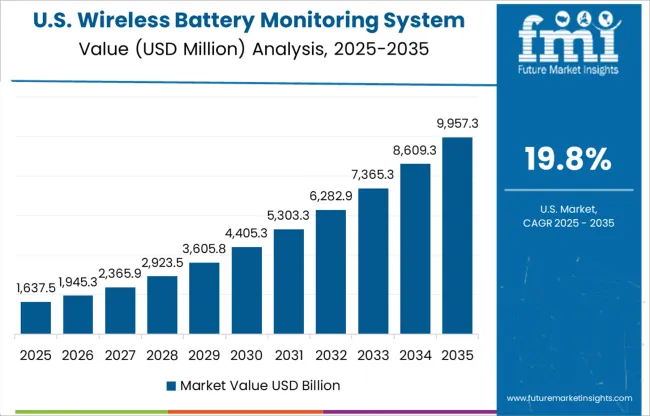
North America is accountable for a 32.60% market share in the global wireless battery monitoring systems market owing to the increasing penetration of electric vehicles. North America has favorable government policies and employment of various supportive government monetary policies for developing hybrid electric vehicles along with growing automotive sales.
This region’s market is dominating owing to the presence of various industry participants and considerable research and development activities in power wireless battery monitoring systems. The American Recovery and Reinvestment Act gives funds for developing hybrid electric vehicles for usage by public and commercial organizations. This factor is predicted to promote the market in countries such as the United States in the North American region.
Following North America, Asia Pacific is known to lead the global wireless battery monitoring systems market. This region is said to have substantial potential growth owing to the increasing adoption of wireless battery monitoring systems along with increasing awareness in organizations for battery protection.
With the growing adoption of electric vehicles in countries like India and China, the Asia Pacific region is anticipated to experience huge demand for wireless battery monitoring systems during the forecast period. There are multiple automotive manufacturers who are expanding their footprint in this region, and this is anticipated to promote the growth of the Asia Pacific wireless battery monitoring systems market.
Startups in the market are evolving due to alteration and fluctuations and innovation of novel technology. This results in the development of new and exciting trends. This research report monitors the start-up ecosystem from across the globe and introduces significant market insights.
For, example In May 2025, Marelli who is a leading global automotive supplier announced the expansion of its range of battery management technologies for electric vehicles with a new state-of-the-art wireless distributed battery management system.
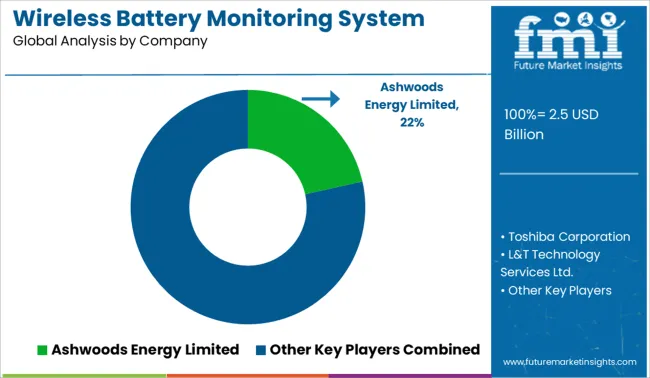
Some of the key players in the wireless battery monitoring system market are Ashwoods Energy Limited, Toshiba Corporation, L&T Technology Services Ltd., Merlin Equipment Ltd., Vecture Inc., Lithium Balance Corporation, and Nuvation Engineering.
| Report Attribute | Details |
|---|---|
| Growth Rate | CAGR of 23.30% from 2025 to 2035 |
| Base Year for Estimation | 2024 |
| Historical Data | 2014 to 2024 |
| Forecast Period | 2025 to 2035 |
| Quantitative Units | Revenue in USD million and CAGR from 2025 to 2035 |
| Report Coverage | Revenue Forecast, Volume Forecast, Company Ranking, Competitive Landscape, Growth Factors, Trends, and Pricing Analysis |
| Segments Covered | Component, Battery Type, Application, Region |
| Regions Covered | North America; Latin America; Europe; East Asia; South Asia; Oceania; Middle East and Africa |
| Key Countries Profiled | United States of America, Canada, Brazil, Argentina, Germany, United Kingdom, France, Spain, Italy, Nordics, BENELUX, Australia & New Zealand, China, India, ASEAN, GCC Countries, South Africa |
| Key Companies Profiled | Ashwoods Energy Limited; Toshiba Corporation; L&T Technology Services Ltd.; Merlin Equipment Ltd.; Vecture Inc.; Lithium Balance Corporation; Nuvation Engineering. |
| Customization | Available Upon Request |
The global wireless battery monitoring system market is estimated to be valued at USD 2.5 billion in 2025.
The market size for the wireless battery monitoring system market is projected to reach USD 20.4 billion by 2035.
The wireless battery monitoring system market is expected to grow at a 23.3% CAGR between 2025 and 2035.
The key product types in wireless battery monitoring system market are hardware, software and services.
In terms of battery type, lithium-ion segment to command 61.2% share in the wireless battery monitoring system market in 2025.






Our Research Products

The "Full Research Suite" delivers actionable market intel, deep dives on markets or technologies, so clients act faster, cut risk, and unlock growth.

The Leaderboard benchmarks and ranks top vendors, classifying them as Established Leaders, Leading Challengers, or Disruptors & Challengers.

Locates where complements amplify value and substitutes erode it, forecasting net impact by horizon

We deliver granular, decision-grade intel: market sizing, 5-year forecasts, pricing, adoption, usage, revenue, and operational KPIs—plus competitor tracking, regulation, and value chains—across 60 countries broadly.

Spot the shifts before they hit your P&L. We track inflection points, adoption curves, pricing moves, and ecosystem plays to show where demand is heading, why it is changing, and what to do next across high-growth markets and disruptive tech

Real-time reads of user behavior. We track shifting priorities, perceptions of today’s and next-gen services, and provider experience, then pace how fast tech moves from trial to adoption, blending buyer, consumer, and channel inputs with social signals (#WhySwitch, #UX).

Partner with our analyst team to build a custom report designed around your business priorities. From analysing market trends to assessing competitors or crafting bespoke datasets, we tailor insights to your needs.
Supplier Intelligence
Discovery & Profiling
Capacity & Footprint
Performance & Risk
Compliance & Governance
Commercial Readiness
Who Supplies Whom
Scorecards & Shortlists
Playbooks & Docs
Category Intelligence
Definition & Scope
Demand & Use Cases
Cost Drivers
Market Structure
Supply Chain Map
Trade & Policy
Operating Norms
Deliverables
Buyer Intelligence
Account Basics
Spend & Scope
Procurement Model
Vendor Requirements
Terms & Policies
Entry Strategy
Pain Points & Triggers
Outputs
Pricing Analysis
Benchmarks
Trends
Should-Cost
Indexation
Landed Cost
Commercial Terms
Deliverables
Brand Analysis
Positioning & Value Prop
Share & Presence
Customer Evidence
Go-to-Market
Digital & Reputation
Compliance & Trust
KPIs & Gaps
Outputs
Full Research Suite comprises of:
Market outlook & trends analysis
Interviews & case studies
Strategic recommendations
Vendor profiles & capabilities analysis
5-year forecasts
8 regions and 60+ country-level data splits
Market segment data splits
12 months of continuous data updates
DELIVERED AS:
PDF EXCEL ONLINE
Wireless EEG Monitoring System Market Size and Share Forecast Outlook 2025 to 2035
Wireless Paging Systems Market Size and Share Forecast Outlook 2025 to 2035
Wireless Patient Monitoring Market Size and Share Forecast Outlook 2025 to 2035
Battery Management System Market Report – Growth & Forecast 2025-2035
Competitive Breakdown of Battery Management System Providers
EV Battery Heating System Market Size and Share Forecast Outlook 2025 to 2035
Battery Energy Storage System Industry Analysis by Battery Type, Connection Type, Ownership, Energy Capacity, Storage System, Application, and Region through 2025 to 2035
Neuro-monitoring System Market Size and Share Forecast Outlook 2025 to 2035
Urine Monitoring Systems Market Analysis - Size, Trends & Forecast 2025 to 2035
Brain Monitoring Systems Market is segmented by Lateral Flow Readers and Kits and Reagents from 2025 to 2035
Yield Monitoring Systems Market
Wireless Fire Detection Systems Market Analysis - Size, Growth, and Forecast 2025 to 2035
Driver Monitoring System Market Growth - Trends & Forecast 2025 to 2035
Tunnel Monitoring System Market Growth - Trends & Forecast 2025 to 2035
Patient Monitoring System Market Size and Share Forecast Outlook 2025 to 2035
B-Ketone Monitoring System Market Size and Share Forecast Outlook 2025 to 2035
Pipeline Monitoring System Market Size and Share Forecast Outlook 2025 to 2035
Air Flow Monitoring System Market
Emission Monitoring Systems Market
Condition Monitoring System Market Size and Share Forecast Outlook 2025 to 2035

Thank you!
You will receive an email from our Business Development Manager. Please be sure to check your SPAM/JUNK folder too.
Chat With
MaRIA